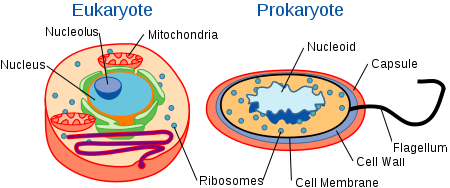What Is A Cell in Biology?
Cells are the primary unit of life. Some organisms are made from a single cell, inclusive of bacteria, whilst others are made from trillions of cells. Humans also are made from cells.
Different Types of Cells in Biology:
There are many types of cells in Biology. Each cell type is different and performs a different function. In the human body, we have nerve cells that can reach from the foot to the spinal cord. Nerve cells help carry messages throughout the body. We also have billions of tiny brain cells that help us think and muscle cells that help us move. There are many cells in our body that help us function and sustain life.
Although there are many different types of cells, they are generally divided into two main types: prokaryotic cells and eukaryotic cells.
Prokaryotic Cell – A prokaryotic cell is a small, simple cell without a nucleus. Organisms are made of very small prokaryotic cells, like bacteria. There are three main regions of prokaryotic cells:
1) The outer protective layer or “sheath” of the cell. It is composed of cell wall, membrane and capsule.
2) Flagella, which are flagella-like appendages that can help cells move. Note: Not all prokaryotic cells have flagella.
3) The interior of the cell is called the cytoplasmic region. This region includes nucleoid, cytoplasm and ribosome.
Eukaryotic Cells –
These cells are usually much larger and more complex than prokaryotic cells. They have a definite cell nucleus that contains the cell’s DNA. These are the types of cells we find in plants and animals.

Parts of the Cell:
There are many parts and functions in some cells. Here are some key components of many cells:
Membrane – This is the outer boundary of the cell. Kind of like leather. It allows some substances to enter and prevents others from entering.
Mitochondria – This is where the cell gets energy. In the human body, the food we have digested reacts with the oxygen in the mitochondria to produce energy for the cells.
Ribosomes: Ribosomes are like little factories that make different things that cells need to function, such as proteins.
Nucleus – The nucleus is the brain of the cell. It uses chromosomes to tell the rest of the cell what to do next.
Cytoplasm – This is what fills the rest of the cell. Other components of the cell float in the cytoplasm. It is mainly water.
Lysosomes – These clean the place by removing waste and other unwanted substances that can enter the cell.
The machinery inside the cell such as the nucleus, ribosomes and lysosomes is called organelles.
Interesting facts about cell:
They were discovered by scientist Robert Hooke. One of the largest known cells is an ostrich egg that can weigh more than 3 pounds.
- When many cells of the same type join together in a group, it is called a tissue.
- The word umbrella comes from the Latin cellula, which means small compartment.
- Humans actually carry more bacterial cells than human cells. It’s disgusting!

